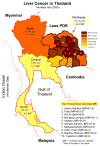Cholangiocarcinoma: lessons from Thailand
- PMID: 18408464
- PMCID: PMC4130346
- DOI: 10.1097/MOG.0b013e3282fbf9b3
Cholangiocarcinoma: lessons from Thailand
Abstract
Purpose of review: To present the background of liver fluke-associated cholangiocarcinoma in Thailand focusing on recent epidemiological data and pathogenesis of this bile duct cancer.
Recent findings: More systematic tumor registration in Thailand nowadays uncovers new high-incidence areas that are confined to not only the northeastern part but also some provinces in northern Thailand. The link between the liver fluke, Opisthorchis viverrini, and cholangiocarcinoma, particularly in terms of cellular and molecular pathogenesis, is further elucidated.
Summary: Thailand is still the country with the highest incidence of cholangiocarcinoma in the world. Liver fluke induces chronic inflammation leading to oxidative DNA damage of the infected biliary epithelium and malignant transformation. Eradication of the fluke and identification of high-risk populations are urgently needed.
Figures



 Eggs are ingested by a suitable snail intermediate host
Eggs are ingested by a suitable snail intermediate host
 there are more than 100 species of snails that can serve as intermediate hosts. Each egg releases a miracidium
there are more than 100 species of snails that can serve as intermediate hosts. Each egg releases a miracidium
 which goes through several developmental stages (sporocyst
which goes through several developmental stages (sporocyst
 redia
redia
 and cercaria
and cercaria
 ). The cercaria is released from the snail and after a short period of free-swimming time in water, it comes into contact with and penetrates the flesh of a freshwater fish, such as Cyclocheilichthys armatus or Puntius leiacanthus, where it encysts as a metacercaria
). The cercaria is released from the snail and after a short period of free-swimming time in water, it comes into contact with and penetrates the flesh of a freshwater fish, such as Cyclocheilichthys armatus or Puntius leiacanthus, where it encysts as a metacercaria
 Infection of humans occurs by ingestion of undercooked, salted, pickled, or smoked freshwater fishes
Infection of humans occurs by ingestion of undercooked, salted, pickled, or smoked freshwater fishes
 . After ingestion, the metacercaria excysts in the duodenum
. After ingestion, the metacercaria excysts in the duodenum
 and ascends the biliary tract through the ampulla of Vater. Maturation to adults, Opisthorchis viverrini
and ascends the biliary tract through the ampulla of Vater. Maturation to adults, Opisthorchis viverrini
 takes approximately 1 month. The adult flukes (measuring 10 to 15 mm by 3 to 5 mm) reside in the small and medium sized biliary ducts. In addition to humans, carnivorous animals can serve as reservoir hosts. (Adapted from
takes approximately 1 month. The adult flukes (measuring 10 to 15 mm by 3 to 5 mm) reside in the small and medium sized biliary ducts. In addition to humans, carnivorous animals can serve as reservoir hosts. (Adapted from 

References
-
- Patel T, Singh P. Cholangiocarcinoma: emerging approaches to a challenging cancer. Curr Opin Gastroenterol. 2007;23:317–323. - PubMed
-
- Kamangar F, Dores GM, Anderson WF. Patterns of cancer incidence, mortality, and prevalence across five continents: defining priorities to reduce cancer disparities in different geographic regions of the world. J Clin Oncol. 2006;24:2137–2150. This report intensively summarizes the global cancer profiles and highlights eight common cancers and associated important risk factors, cancer control and prevention measure. - PubMed
-
- Jemal A, Siegel R, Ward E, et al. Cancer statistics, 2007. CA Cancer J Clin. 2007;57:43–66. This report describes the cancer statistics on incidence, mortality rate and survival in the United States. - PubMed
-
- Parkin DM, Bray F, Ferlay J, et al. Global cancer statistics, 2002. CA Cancer J Clin. 2005;55:74–108. - PubMed
Publication types
MeSH terms
Grants and funding
LinkOut - more resources
Full Text Sources
Other Literature Sources
Medical
Research Materials

